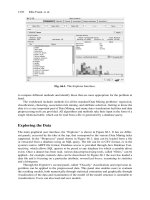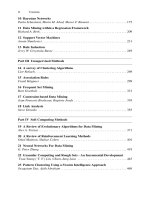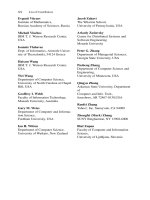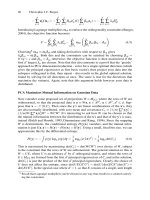Data Mining and Knowledge Discovery Handbook, 2 Edition part 29 pdf
Bạn đang xem bản rút gọn của tài liệu. Xem và tải ngay bản đầy đủ của tài liệu tại đây (369.18 KB, 10 trang )
260 Jerzy W. Grzymala-Busse
13.3.3 AQ
Another rule induction algorithm, developed by R. S. Michalski and his collaborators
in the early seventies, is an algorithm called AQ. Many versions of the algorithm have
been developed, under different names (Michalski et al., 1986A), (Michalski et al.,
1986A).
Let us start by quoting some definitions from (Michalski et al., 1986A), (Michal-
ski et al., 1986A). Let A be the set of all attributes,
A = {A
1
,A
2
, ,A
k
}.Aseed is a member of the concept, i.e., a positive case. A se-
lector is an expression that associates a variable (attribute or decision) to a value of
the variable, e.g., a negation of value, a disjunction of values, etc. A complex is a
conjunction of selectors. A partial star G(e|e
1
) is a set of all complexes describing
the seed e =(x
1
,x
2
, ,x
k
) and not describing a negative case e
1
=(y
1
,y
2
, ,y
k
).
Thus, the complexes of G(e|e1) are conjunctions of selectors of the form (A
i
,¬y
i
),
for all i such that x
i
= y
i
.Astar G(e|F) is constructed from all partial stars G(e|e
i
),
for all e
i
∈ F, and by conjuncting these partial stars by each other, using absorption
law to eliminate redundancy. For a given concept C,acover is a disjunction of com-
plexes describing all positive cases from C and not describing any negative cases
from F = U −C.
The main idea of the AQ algorithm is to generate a cover for each concept by
computing stars and selecting from them single complexes to the cover.
For the example from Table 13.1, and concept C = {1,2,4,5} described by (Flu,
yes), set F of negative cases is equal to 3, 6, 7. A seed is any member of C, say that
it is case 1. Then the partial star G(1|3) is equal to
{(Temperature,¬normal),(Headache,¬no),(Weakness,¬no)}.
Obviously, partial star G(1|3) describes negative cases 6 and 7. The partial star
G(1|6) equals
{(Temperature,¬high),(Headache,¬no),(Weakness,¬no)}
The conjunct of G(1|3) and G(1|6) is equal to
{(Temperature,very
high),
(Temperature,¬normal) & (Headache,¬no),
(Temperature,¬normal) & (Weakness, ¬no),
(Temperature,¬high) & (Headache, ¬no),
(Headache,¬no),
(Headache,¬no) & (Weakness, ¬no),
(Temperature,¬high) & (Weakness,¬no),
(Headache,¬no) & Weakness, ¬no),
(Weakness,¬no)},
13 Rule Induction 261
after using the absorption law, this set is reduced to the following set
G(1|{3,6}):
{(Temperature,very
high),(Headache¬no),(Weakness,¬no)}.
The preceding set describes negative case 7. The partial star G(1|7) is equal to
{(Temperature,¬normal),Headache,¬no)}.
The conjunct of G(1|{3,6}) and G(1|7) is
{(Temperature,very
high),
(Temperature,very
high) & (Headache, ¬no),
(Temperature,¬normal) & Headache,¬no),
(Headache,¬no),
(Temperature,¬normal) & (Weakness, ¬no),
(Headache,¬no) & (Weakness, ¬no)}.
The above set, after using the absorption law, is already a star G(1|F)
{(Temperature,very
high),
(Headache,¬no),
(Temperature,¬normal) & (Weakness, ¬no)}.
The first complex describes only one positive case 1, while the second complex
describes three positive cases: 1, 2, and 4. The third complex describes two positive
cases: 1 and 5. Therefore, the complex
(Headache,¬no)
should be selected to be a member of the star of C. The corresponding rule is
(Headache,¬no) → (Flu,yes).
If rules without negation are preferred, the preceding rule may be replaced by the
following rule
(Headache,yes) → (Flu,yes).
The next seed is case 5, and the partial star G(5|3) is the following set
{(Temperature,¬normal),(Weakness,¬no)}.
262 Jerzy W. Grzymala-Busse
The partial star G(5|3) covers cases 6 and 7. Therefore, we compute G(5|6),
equal to
{(Weakness,¬no)}
A conjunct of G(5|3) and G(5|6) is the following set
{(Temperature,¬normal) & (Weakness, ¬no), (Weakness,¬no)}
After simplification, the set G(5|{3,6}) equals
{Weakness,¬no)}.
The above set covers case 7. The set G(5|7) is equal to
{(Temperature,¬normal)}
Finally, the partial star G(5|{3,6, 7}) is equal to
{(Temperature,¬normal) & (Weakness, ¬no)},
so the second rule describing concept {1, 2, 4, 5} is
(Temperature,¬normal) & (Weakness, ¬no) → (Flu, yes).
It is not difficult to see that the following rules describe the second concept from
Table 13.1:
Temperature,¬high) & (Headache,¬yes) → (Flu,no),
(Headache,¬yes) & (Weakness, ¬yes) → (Flu,no).
Note that the AQ algorithm demands computing conjuncts of partial stars. In the
worst case, time complexity of this computation is O(n
m
), where n is the number of
attributes and m is the number of cases. The authors of AQ suggest using the param-
eter MAXSTAR as a method of reducing the computational complexity. According
to this suggestion, any set, computed by conjunction of partial stars, is reduced in
size if the number of its members is greater than MAXSTAR. Obviously, the quality
of the output of the algorithm is reduced as well.
13.4 Classification Systems
Rule sets, induced from data sets, are used mostly to classify new, unseen cases. Such
rule sets may be used in rule-based expert systems.
There is a few existing classification systems, e.g., associated with rule induction
systems LERS or AQ. A classification system used in LERS is a modification of the
well-known bucket brigade algorithm (Booker et al., 1990), (Holland et al., 1986),
(Stefanowski, 2001). In the rule induction system AQ, the classification system is
13 Rule Induction 263
based on a rule estimate of probability (Michalski et al., 1986A), (Michalski et al.,
1986A). Some classification systems use a decision list, in which rules are ordered,
the first rule that matches the case classifies it (Rivest, 1987). In this section we will
concentrate on a classification system associated with LERS.
The decision to which concept a case belongs is made on the basis of three fac-
tors: strength, specificity, and support. These factors are defined as follows: strength
is the total number of cases correctly classified by the rule during training. Speci-
ficity is the total number of attribute-value pairs on the left-hand side of the rule. The
matching rules with a larger number of attribute-value pairs are considered more
specific. The third factor, support, is defined as the sum of products of strength and
specificity for all matching rules indicating the same concept. The concept C for
which the support, i.e., the following expression
∑
matching rules r describing C
Strength(r) ∗Speci f icity(r)
is the largest is the winner and the case is classified as being a member of C.
In the classification system of LERS, if complete matching is impossible, all
partially matching rules are identified. These are rules with at least one attribute-
value pair matching the corresponding attribute-value pair of a case. For any par-
tially matching rule r, the additional factor, called Matching
factor (r), is computed.
Matching
factor (r) is defined as the ratio of the number of matched attribute-value
pairs of r with a case to the total number of attribute-value pairs of r. In partial
matching, the concept C for which the following expression is the largest
∑
partially matching
rules r describing C
Matching factor(r) ∗Strength(r)
∗ Speci f icity(r)
is the winner and the case is classified as being a member of C.
13.5 Validation
The most important performance criterion of rule induction methods
is the error rate. A complete discussion on how to evaluate the error rate from a
data set is contained in (Weiss and Kulikowski, 1991). If the number of cases is less
than 100, the leaving-one-out method is used to estimate the error rate of the rule set.
In leaving-one-out, the number of learn-and-test experiments is equal to the number
of cases in the data set. During the i-th experiment, the i-th case is removed from the
data set, a rule set is induced by the rule induction system from the remaining cases,
and the classification of the omitted case by rules produced is recorded. The error
rate is computed as
total number o f misclassi f ications
number o f cases
.
264 Jerzy W. Grzymala-Busse
On the other hand, if the number of cases in the data set is greater than or equal to
100, the ten-fold cross-validation will be used. This technique is similar to leaving-
one-out in that it follows the learn-and-test paradigm. In this case, however, all cases
are randomly re-ordered, and then a set of all cases is divided into ten mutually
disjoint subsets of approximately equal size. For each subset, all remaining cases
are used for training, i.e., for rule induction, while the subset is used for testing.
This method is used primarily to save time at the negligible expense of accuracy.
Ten-fold cross validation is commonly accepted as a standard way of validating
rule sets. However, using this method twice, with different preliminary random re-
ordering of all cases yields—in general—two different estimates for the error rate
(Grzymala-Busse, 1997).
For large data sets (at least 1000 cases) a single application of the train-and-
test paradigm may be used. This technique is also known as
holdout
(Weiss and
Kulikowski, 1991). Two thirds of cases should be used for training, one third for
testing.
13.6 Advanced Methodology
Some more advanced methods of machine learning in general and rule induction
in particular were discussed in (Dietterich, 1997). Such methods include combining
a few rule sets with associated classification systems, created independently, using
different algorithms, to classify a new case by taking into account all individual de-
cisions and using some mechanisms to resolve conflicts, e.g., voting. Another impor-
tant problem is scaling up rule induction algorithms. Yet another important problem
is learning from imbalanced data sets (Japkowicz, 2000), where some concepts are
extremely small.
References
Booker L.B., Goldberg D.E., and Holland J.F. Classifier systems and genetic algorithms.
In Machine Learning. Paradigms and Methods, Carbonell, J. G. (ed.), The MIT Press,
Boston, MA, 1990, 235–282.
Chan C.C. and Grzymala-Busse J.W. On the attribute redundancy and the learning programs
ID3, PRISM, and LEM2. Department of Computer Science, University of Kansas, TR-
91-14, December 1991, 20 pp.
Dietterich T.G. Machine-learning research. AI Magazine 1997: 97–136.
Grzymala-Busse J.W. Knowledge acquisition under uncertainty—A rough set approach.
Journal of Intelligent & Robotic Systems 1988; 1: 3–16.
Grzymala-Busse J.W. LERS—A system for learning from examples based on rough sets. In
Intelligent Decision Support. Handbook of Applications and Advances of the Rough Sets
Theory, ed. by R. Slowinski, Kluwer Academic Publishers, Dordrecht, Boston, London,
1992, 3–18.
Grzymala-Busse J.W. A new version of the rule induction system LERS, Fundamenta Infor-
maticae 1997; 31: 27–39.
13 Rule Induction 265
Holland J.H., Holyoak K.J., and Nisbett R.E. Induction. Processes of Inference, Learning,
and Discovery, MIT Press, Boston, MA, 1986.
Japkowicz N. Learning from imbalanced data sets: a comparison of various strategies. Learn-
ing from Imbalanced Data Sets, AAAI Workshop at the 17th Conference on AI, AAAI-
2000, Austin, TX, July 30–31, 2000, 10–17.
Michalski R.S. A Theory and Methodology of Inductive Learning. In Machine Learning. An
Artificial Intelligence Approach, Michalski, R. S., J. G. Carbonell and T. M. Mitchell
(eds.), Morgan Kauffman, San Mateo, CA, 1983, 83–134.
Michalski R.S., Mozetic I., Hong J., Lavrac N. The AQ15 inductive learning system: An
overview and experiments, Report 1260, Department of Computer Science, University
of Illinois at Urbana-Champaign, 1986A.
Michalski R.S., Mozetic I., Hong J., Lavrac N. The multi-purpose incremental learning sys-
tem AQ 15 and its testing application to three medical domains. Proc. of the 5th Nat.
Conf. on AI, 1986B, 1041–1045.
Pawlak Z.: Rough Sets. International Journal of Computer and Information Sciences 1982;
11: 341–356.
Pawlak Z. Rough Sets. Theoretical Aspects of Reasoning about Data. Kluwer Academic
Publishers, Dordrecht, Boston, London, 1991.
Pawlak Z., Grzymala-Busse J.W., Slowinski R. and Ziarko, W. Rough sets. Communications
of the ACM 1995; 38: 88–95.
Rivest R.L. Learning decision lists. Machine Learning 1987; 2: 229–246.
Stefanowski J. Algorithms of Decision Rule Induction in Data Mining. Poznan University of
Technology Press, Poznan, Poland, 2001.
Weiss S. and Kulikowski C.A. Computer Systems That Learn: Classification and Prediction
Methods from Statistics, Neural Nets, Machine Learning, and Expert Systems, chapter
How to Estimate the True Performance of a Learning System, pp. 17–49, San Mateo,
CA: Morgan Kaufmann Publishers, Inc., 1991.
Part III
Unsupervised Methods
14
A survey of Clustering Algorithms
Lior Rokach
Department of Information Systems Engineering
Ben-Gurion University of the Negev
Summary. This chapter presents a tutorial overview of the main clustering methods used in
Data Mining. The goal is to provide a self-contained review of the concepts and the mathemat-
ics underlying clustering techniques. The chapter begins by providing measures and criteria
that are used for determining whether two objects are similar or dissimilar. Then the clustering
methods are presented, divided into: hierarchical, partitioning, density-based, model-based,
grid-based, and soft-computing methods. Following the methods, the challenges of perform-
ing clustering in large data sets are discussed. Finally, the chapter presents how to determine
the number of clusters.
Key words: Clustering, K-means, Intra-cluster homogeneity, Inter-cluster separa-
bility,
14.1 Introduction
Clustering and classification are both fundamental tasks in Data Mining. Classifi-
cation is used mostly as a supervised learning method, clustering for unsupervised
learning (some clustering models are for both). The goal of clustering is descriptive,
that of classification is predictive (Veyssieres and Plant, 1998). Since the goal of clus-
tering is to discover a new set of categories, the new groups are of interest in them-
selves, and their assessment is intrinsic. In classification tasks, however, an important
part of the assessment is extrinsic, since the groups must reflect some reference set
of classes. “Understanding our world requires conceptualizing the similarities and
differences between the entities that compose it” (Tyron and Bailey, 1970).
Clustering groups data instances into subsets in such a manner that similar in-
stances are grouped together, while different instances belong to different groups.
The instances are thereby organized into an efficient representation that character-
izes the population being sampled. Formally, the clustering structure is represented
as a set of subsets C = C
1
, ,C
k
of S, such that: S =
k
i=1
C
i
and C
i
∩C
j
= /0 for
i = j. Consequently, any instance in S belongs to exactly one and only one subset.
O. Maimon, L. Rokach (eds.), Data Mining and Knowledge Discovery Handbook, 2nd ed.,
DOI 10.1007/978-0-387-09823-4_14, © Springer Science+Business Media, LLC 2010









